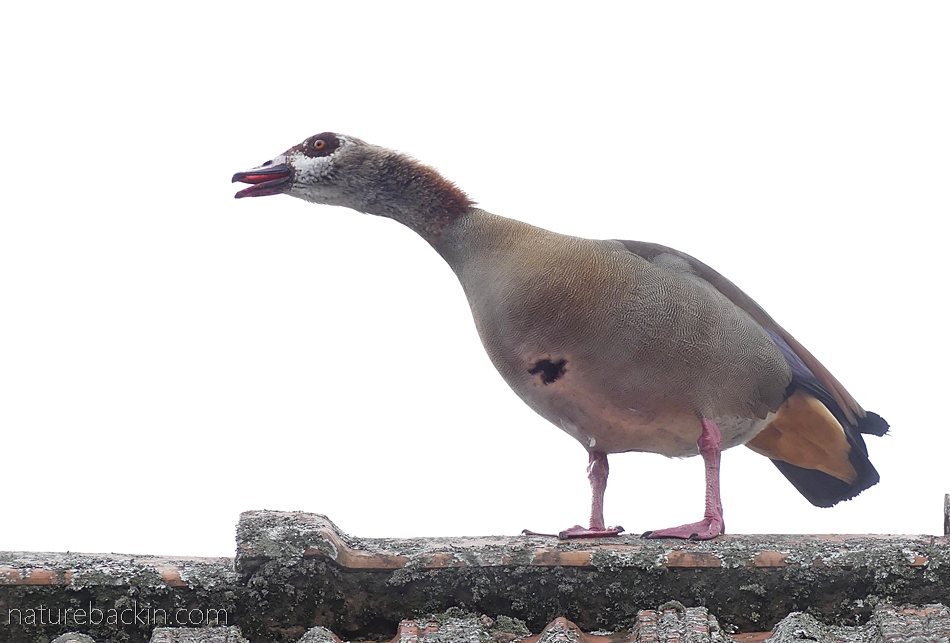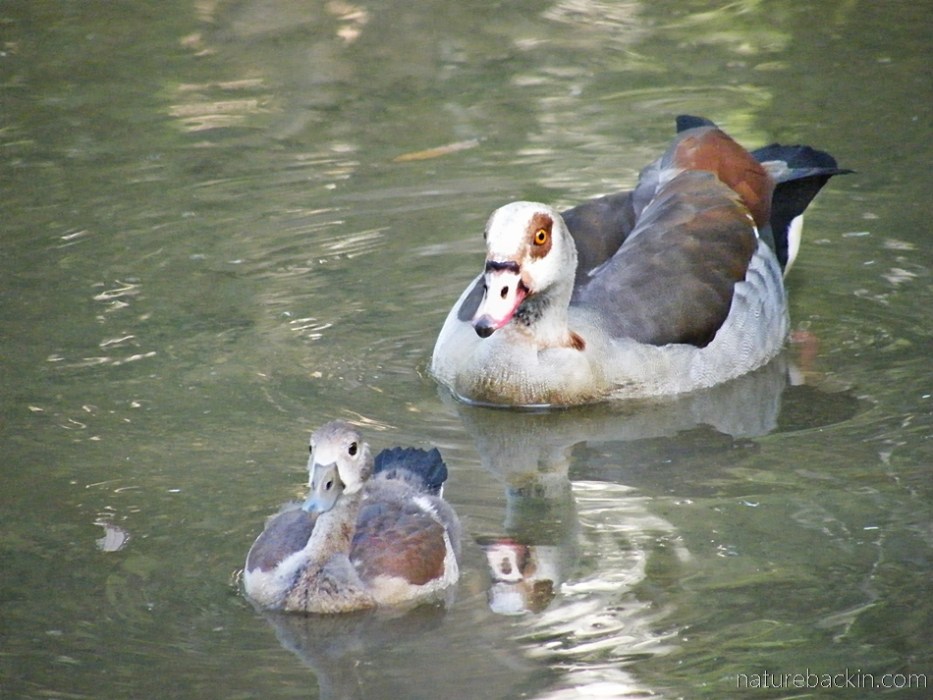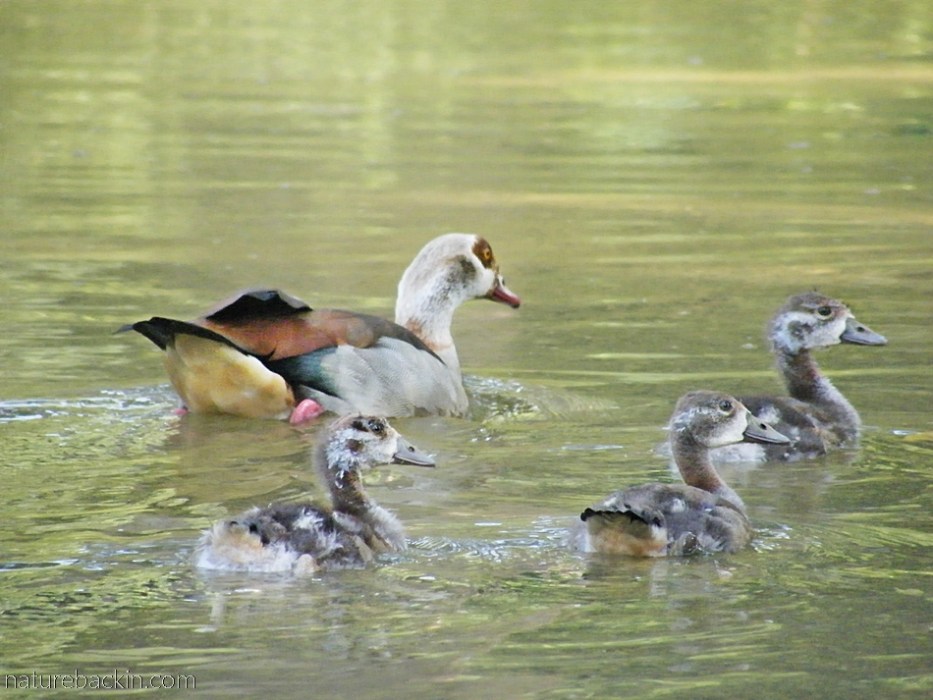Among the swelling signs of spring is the increasingly noticeable and highly vocal activity of Egyptian geese passing through our neighbourhood. The raucous calling of pairs in flight – or even when they alight on the roof of our or a neighbour’s roof – enlivens especially the early mornings and sometimes also the late afternoons.
Typically, Egyptian geese roost in the same site every night, leaving for foraging trips in the early morning and foraging again in the late afternoon. In our area we only notice Egyptian geese activity from about August so they must spend their winters elsewhere.

One morning earlier this week a pair of Egyptian geese spent time on our roof, sometimes calling noisily. Egyptian geese are monogamous and pairs stay together for their whole lives
In southern Africa Egyptian geese may be nomadic and disperse quite considerable distances, often in response to water availability particularly in the drier regions. They occur in the vicinity of largish bodies of water such as lakes, dams, rivers, marshes, pans and estuaries. At the coast, they may swim in harbours or in the sea and they may sometimes forage along the shoreline.
Egyptian geese roost and nest in or near wetlands where they also feed, in addition to flying off to grasslands, flood plains or crop fields for their twice-daily foraging sessions. They mostly eat grass, leaves, seeds, grain, crop seedlings and aquatic rhizomes and tubers. Unfortunately where numbers are high Egyptian geese are regarded as pests by grain farmers and consequently they face being shot or poisoned.
Egyptian geese are known to be gregarious outside of the breeding season, congregating in flocks – although pairs remain together keeping their distance from other geese. Egyptian geese also migrate to and congregate at specific wetlands seasonally when moulting their wing feathers. They remain flightless for about five weeks as their flight feathers regrow.

Walk like an Egyptian
I had assumed that the resumption of noisy activity by Egyptian geese in our neighbourhood was linked to breeding activity. Although Egyptian geese may breed throughout the year with breeding periods varying depending on the region, in KwaZulu-Natal peak breeding times are July to October, which corresponds with the more vocal activities commencing in the spring that we notice where we are.
When a pair takes off to fly, both birds honk and then they may proceed to call in duet when in flight, with the female making a more honking call and the male a more rasping call. Roberts’ Birds of Southern Africa suggests that this calling in flight may be agonistic, that is combative, and it certainly sounds so! When they feel threatened both birds may hiss in response.
Sound recordings of the calls of Egyptian geese can be heard at xeno-canto, which also has a distribution map. Egyptian geese occur over most of sub-Saharan Africa and in the Nile valley. They have been introduced into the United Kingdom and parts of Europe, such as the Netherlands, where feral populations exist.

A female Egyptian goose, honking while looking in the direction of her mate who was concealed from my view on the other side of the roof

Although I could hear him calling, I only realised the second goose was nearby on the other side of the roof when his head and an outspread wing suddenly popped up into view
In or near wetlands, Egyptian geese make nests on the ground where the nest is little more than a small hollow or scrape lined with grass and down. But breeding pairs may also nest in hollows in trees, cliffs, caves or buildings. They may also take over nests of crows, hamerkops or raptors, such as black sparrowhawks. Unfortunately, they don’t only use vacated nests but may aggressively chase off nesting birds when wanting to take over their nest.
(For more about black sparrowhawks and interactions with Egyptian geese see this previous post https://naturebackin.com/2017/03/16/black-sparrowhawks-in-urban-areas-where-to-now/).
Only the female incubates the eggs for about a month with the male standing guard. The fledglings leave the nest about six hours after hatching in response to a call from the female. They will jump even from very high nests, sometimes being stunned for several minutes after hitting the ground. After leaving the nest, the young are escorted to water by both parents.

Not in our garden, these babies with their parents (only one parent in the photo) were swimming in a pond at our local park. This photo was taken a few years ago. Sadly, the pond was dredged and is no more

Also at the park, in a smaller pond, an older chick swims nearby one of the parents. The fledgling period is about 8 to 10 weeks in duration

There were three youngsters remaining in this brood. When danger threatens the adults call the youngsters to the water
Egyptian geese chicks spend much of their time foraging. They predominantly eat grass and grass seeds, but supplement this diet by eating invertebrates, such as ants, caterpillars, moths, crickets, beetles and earthworms. By contrast the adults are almost exclusively herbivorous.
Both adults protect their chicks from predators and other potential threats. I heard of an instance when a male black sparrowhawk flew down and tried to take an Egyptian goose chick while the parents were shepherding their brood across a carpark. Without hesitation the parents attacked the sparrowhawk and killed it.

Egyptian geese parents are fearless in defence of their nest and chicks
Egyptian geese (Alopochen aegyptiaca) is the only species in its genus. (Two or three other species in the genus were hunted to extinction in the 17th century. They occurred in Madagascar and the Mascarene islands.) The genus Alopochen is placed in the subfamily Tadorninae, in which shelducks have also been placed. Tadorninae are regarded as being intermediate between geese and dabbling ducks (see here).
Typical of geese in general are the life-long monogamous and primarily herbivorous lifestyles of Egyptian geese. As we settle into summer so the activities of the Egyptian geese will likely settle too as the nesting and breeding cycle gets further underway.

A gust of wind ruffles the feathers of an Egyptian goose perched on the roof of our house
Sources: Maclean, Gordon Lindsay. 1993. Roberts Birds of Southern Africa (6th edition). Cape Town: Trustees of the John Voelcker Bird Book Fund; Roberts VII Multimedia Birds of Southern Africa: PC Edition. 1997-2016 Southern African Birding. For details go to http://www.sabirding.co.za/roberts7/portal.html
Posted by Carol









September 19, 2020 at 5:17 am
What stunning birds. They sound much like our Canada Geese, but I prefer the subtle coloring your egyptians have. There is something so very elemental and stirring about the call of wild geese going overhead. I often have to stop whatever I’m doing to listen and watch them fly by,
LikeLiked by 1 person
September 20, 2020 at 7:45 pm
Thanks Gunta. From where we sit I always think there is greater romance attached to the Canada Geese, perhaps because of their long migrations, but I gather that increasing populations of resident (non-migrating) birds are leading to some problems. It sounds to be complicated.
LikeLike
September 9, 2020 at 2:32 pm
I always enjoyed seeing these geese when I visited RSA, Carol. And now I’ve learned a lot more about them – thank you! The notion of the youngsters dropping to the ground is quite hair-raising; I’m not surprised some are stunned for a while! I was also not aware that we have them here. I shall be on the watch for them in future.
LikeLiked by 2 people
September 10, 2020 at 2:52 pm
Agreed about the chicks dropping so far. There are some gut-wrenching videos of ducklings and goslings dropping from high nests on YouTube. Not all survive such falls.
Egyptian geese breeding outside their native range is not such a good thing for birds they might displace, sadly.
LikeLiked by 1 person
September 6, 2020 at 4:36 am
Hello Carol,
They are such striking birds! Egyptian geese are a real favorite among Japanese bird-lovers. Our country may not be their natural habitat, but every now and then a lone one somehow makes its way over here and then moves on.
Thank you so much for sharing! 🙂
LikeLiked by 2 people
September 6, 2020 at 7:33 pm
They are very striking and a real presence. That is interesting that occasionally a lone bird makes its way to Japan, but then moves on.
LikeLiked by 2 people
September 5, 2020 at 2:11 pm
It is interesting to see them in their native habitat. As you mention, they’ve been introduced into the UK and may become an invasive species here, like so many others before them.
LikeLiked by 2 people
September 6, 2020 at 7:31 pm
I have read that Egyptian geese in the UK are breeding more successfully due to generally warmer weather patterns in recent years, which must be a worry for native species that might be displaced.
LikeLiked by 1 person
September 5, 2020 at 12:30 pm
There seem to be more Egyptian geese than ever this season. They are everywhere!
LikeLiked by 2 people
September 6, 2020 at 7:20 pm
I wonder why there seem to be more around in this region this season. Perhaps they are predicting decent rain!
LikeLike
September 5, 2020 at 9:37 am
I enjoy seeing Egyptian Geese and so found this an interesting read – with beautiful photographs as usual! How sad that the local pond was dredged and is no more! We need all the ‘wetlands’ we can get!
LikeLiked by 2 people
September 6, 2020 at 7:18 pm
Thanks Anne. Indeed it is very sad about the pond in the park. It was controversial at the time, and I have not been back to the park since …
LikeLike
September 7, 2020 at 3:55 am
I am not surprised.
LikeLiked by 1 person
September 4, 2020 at 11:58 am
Somewhere in my collection I have a photo or two of Egyptian Geese on the roof of my little cottage (rented) in Honeydew, Gauteng. I think I even have a video of them honking away to each other. The delicate markings on their feathers below their wings is so intricate and beautiful. I did not realize that they were flightless for 5 weeks, nor that they could oust a bird to take over its nesting site! Lovely photos and interesting post about them!
LikeLiked by 2 people
September 4, 2020 at 7:39 pm
Thanks so much. I hope you find your photos and videos taken in Honeydew. I also love those delicate markings below their wings. They are very strikingly marked birds. I knew about spurwing geese moulting but it was new to me too that Eqyptian geese also have moult migrations.
LikeLiked by 1 person
September 4, 2020 at 8:16 am
Lovely post Carol! Many years ago in Delta Park, Blairgowrie, Johannesburg, we watched parents usher their young down a drainpipe off a high roof where the nest was situated, to take them to a nearby dam. Finally all the young were safely down and waddled off in single file. It was a very special sighting. xxx
LikeLiked by 2 people
September 4, 2020 at 7:36 pm
Thanks Christeen. Wow that was an interesting sighting. Going down the drainpipe sounds a lot safer than jumping from the nest down onto what was likely paved ground below the building. Incredible that they are on the move only a few hours after hatching.
LikeLiked by 1 person
September 4, 2020 at 8:10 am
We are seeing them more and more here in Onrus, Carol. They love to feed amongst washed up sea weeds on the rocks and beaches and to swim between crevices of rock pools.
Macnifisant beautiful birds, but unfortunately our wheat farmers in the neighbourhood Caledon district despise them for obvious reasons you’ve mentioned in your article….
LikeLiked by 2 people
September 4, 2020 at 7:34 pm
It is interesting that they are so adaptable and cope so well the seaside environment as well as with inland waterways and wetlands.
The conflict with farmers is very sad.
LikeLike
September 4, 2020 at 6:46 am
Your photographs of these birds are quite quite remarkable. Thank you for another informative post.
LikeLiked by 2 people
September 4, 2020 at 7:32 pm
Thanks Mariss. I learned a lot about them writing this post that I really should have known before!
LikeLiked by 1 person
September 4, 2020 at 5:38 am
We don’t have Egyptian geese, though plenty of greylag and Canada, flying on immense, noisy skeins over our house to and from one of the nearby wetlands. Yours are handsome beasts!
LikeLiked by 2 people
September 4, 2020 at 7:32 pm
It must be spectacular to see (and hear) those immense skeins of birds on their way. I had to look up the greylag goose – a handsome bird too although in a more understated way than the colourful Egyptian goose.
LikeLiked by 1 person
September 5, 2020 at 7:07 am
Understated. I like that. So much more positive than Dull. Which they aren’t by the way.
LikeLiked by 1 person
September 4, 2020 at 4:11 am
They sound like our Nene geese, and most geese I guess, loud and rambunctious. I certainly don’t mess with them and wouldn’t want to get between mama goose and her goslings. Maybe they’re grouchy because of the way they leave the nest as young ones – down to earth with a thud. Brutal! They have such interesting coloring with that brown eye patch and those colorful wing feathers.
LikeLiked by 1 person
September 4, 2020 at 7:25 pm
It does seem that most geese do have rather extravagant personalities. I like your theory explaining their apparent grouchiness 🙂
LikeLiked by 1 person
September 4, 2020 at 3:36 am
We often hear the honking of Canadian geese as they make their way to a pond in the neighborhood. Sometimes it seems they fly quite low and might brush rooftops (lol).
LikeLiked by 1 person
September 4, 2020 at 7:22 pm
The sound of wild birds calling in flight is so special. It must be quite a sight (and sound) to watch them flying so low overhead.
LikeLiked by 1 person
September 4, 2020 at 8:01 pm
It is. And it happens regularly.
LikeLiked by 1 person
September 4, 2020 at 1:34 am
What a wonderful post about one of our best known and most charismatic birds, Carol.
I don’t mind the racket they make at all and smile everytime our resident pair start waking the neighbourhood on a Sunday morning, but I do get my feathers ruffled when I am trying to get photos of rarer species of ducks and an Egyptian Goose or two become playground bullies and pick on my photographic subject… I’ve even been on the receiving end of their aggression once so I feel for that unfortunate sparrowhawk…
LikeLiked by 1 person
September 4, 2020 at 7:20 pm
I don’t mind the noise either but they are not a constant presence here. I remember my mother objected to the loud tap-dancing impressions they did the metal roof of her house!
I can relate to your ruffled feathers when the geese chase off your photographic subject. That must be quite something to be on the receiving end of their aggression. I have been intimidated by a bevy of very tall domestic geese but never by a wild goose.
LikeLiked by 1 person
September 4, 2020 at 12:39 am
They are pretty looking, but boy, they are noisy!
LikeLiked by 1 person
September 4, 2020 at 7:16 pm
Noisy like most geese I suppose? They are raucous only at the start of the breeding season and only for a relatively brief period of the day and usually they are just passing through. However. one remained alone (and silent) perched in a tree in our garden all day today! Perhaps resting up between foraging trips …
LikeLiked by 1 person